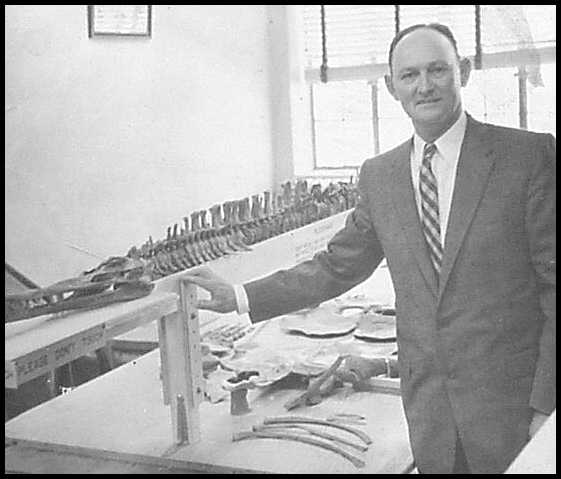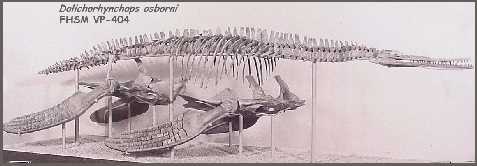Report on a Plesiosaur Skeleton
From Western Kansas.
GEORGE F. STERNBERG and MYRL V. WALKER
Fort Hays Kansas State College, Hays
The Fort Hays Kansas State College Museum has recently
received an important specimen for its Division of Paleontology. This latest accession
consists of an unusually complete skeleton of one of the smaller plesiosaurs of the Kansas
Niobrara Cretaceous. A preliminary study indicates that it is closely related to those
forms known in the scientific literature as Trinacromerum of the family
Polycotylidae.
This very fortunate discovery was made by Mr. M. C. Bonner
of Leoti, Kansas, and he has kindly presented it to the museum. The specimen was collected
from a small exposure of Niobrara Cretaceous a few miles southwest of Russell Springs,
Kansas. The nearly complete skeleton, although somewhat disarticulated, was imbedded in
the bluish chalky-shale member which lies below the reddish-buff chalk in this area.
Fossil vertebrates found in this chalky shale member are usually well replaced and
excellently preserved. This individual is certainly no exception, for the bone is very
hard and dense. This condition greatly facilitated preparation of the specimen, and should
make possible careful and detailed study of the skull, lower jaws and all other portions
of the skeleton.
The general form and size of the skull and lower jaws is
similar to previously described specimens of Trinacromerum; however, there are
some differences in the length of the tooth-bearing surfaces of the premaxillae and
dentary .The suture lines of the skull, as well as other skeletal features, indicate that
the specimen was a fully mature individual.
The vertebral column appears to be nearly complete, and a
majority of the vertebrae are free from crushing or distortion. They are typically
plesiosaurian in structure with conspicuously concave centra and well- developed spinous
processes and articulations. The atlas-axis and all cervicals are present; possibly one or
two dorsals are either absent or reduced in this specimen, and perhaps two to five
terminal caudals may be missing. For the most part, the vertebrae and articulating
surfaces and processes are well preserved. Several complete ribs are present, plus a
number of incomplete and fragmentary rib sections.
Both hind limbs are present and nearly complete except for
a few of the terminal phalanges. The femur is especially well preserved and
Transactions of the Kansas Academy of Science, Vol. 60, No.1,
1957.
[86] |
Report
on a Plesiosaur Skeleton From Western Kansas
87
exhibits strong and conspicuously developed articulating surfaces and rugosities for
muscle attachments. These articulating surfaces and rugosities appear more pronounced than
in any other plesiosaurian genus thus far described in the literature. The fossil bone is
very heavy and dense, and may be indicative of certain skeletal adaptations in these
highly specialized aquatic reptiles of the upper Cretaceous. Only the left forelimb is
present, and the distal elements of all phalanges are missing. The humerus, like the
femur, is well preserved and exhibits strong and conspicuously developed articulating
surfaces and rugosities for muscle attachments.
The most interesting and diagnostic parts of this
plesiosaurian skeleton are the pectoral and pelvic girdles, and fortunately both are
complete in this specimen. The pectoral girdle is composed of the clavicle, interclavicle,
scapula, and the greatly enlarged and specialized coracoid. The size and development of
the coracoid is especially significant in this skeleton, exceeding considerably the
coracoid of previously described specimens.
In the pelvic girdle the pubis and ilium are present and complete, but the distal
portions of both the right and left ischium are missing. Measurements of these elements,
like those in the pectoral girdle, appear to exceed those of previously described species
of Trinacromerum.
The overall length of this skeleton, from the tip of the
premaxillae to the last caudal vertebra, is slightly more than 10 feet, while the greatest
breadth, due to the expanded coracoids, exceeds 30 inches. The depth, measured from the
tip of the longest neural process, along the curved ribs to the coracoid floor, is
approximately 30 inches.
Prior to the discovery of this latest specimen of the small
Cretaceous plesiosaur, only two complete skeletons were known to science. The first was
discovered in 1900 by Mr. George F. Sternberg and is now in the Museum of Natural History
at the University of Kansas. The only other known specimen with nearly complete skeleton
was also found by Mr. Sternberg. It was collected in 1926 and is now in the Harvard
Museum.
No attempt is being made at this time to assign this latest
accession to any previously described genus or species of plesiosaur. A detailed
description of the skeleton, supplemented by photographs, illustrations and measurements,
is planned for the near future.
|



